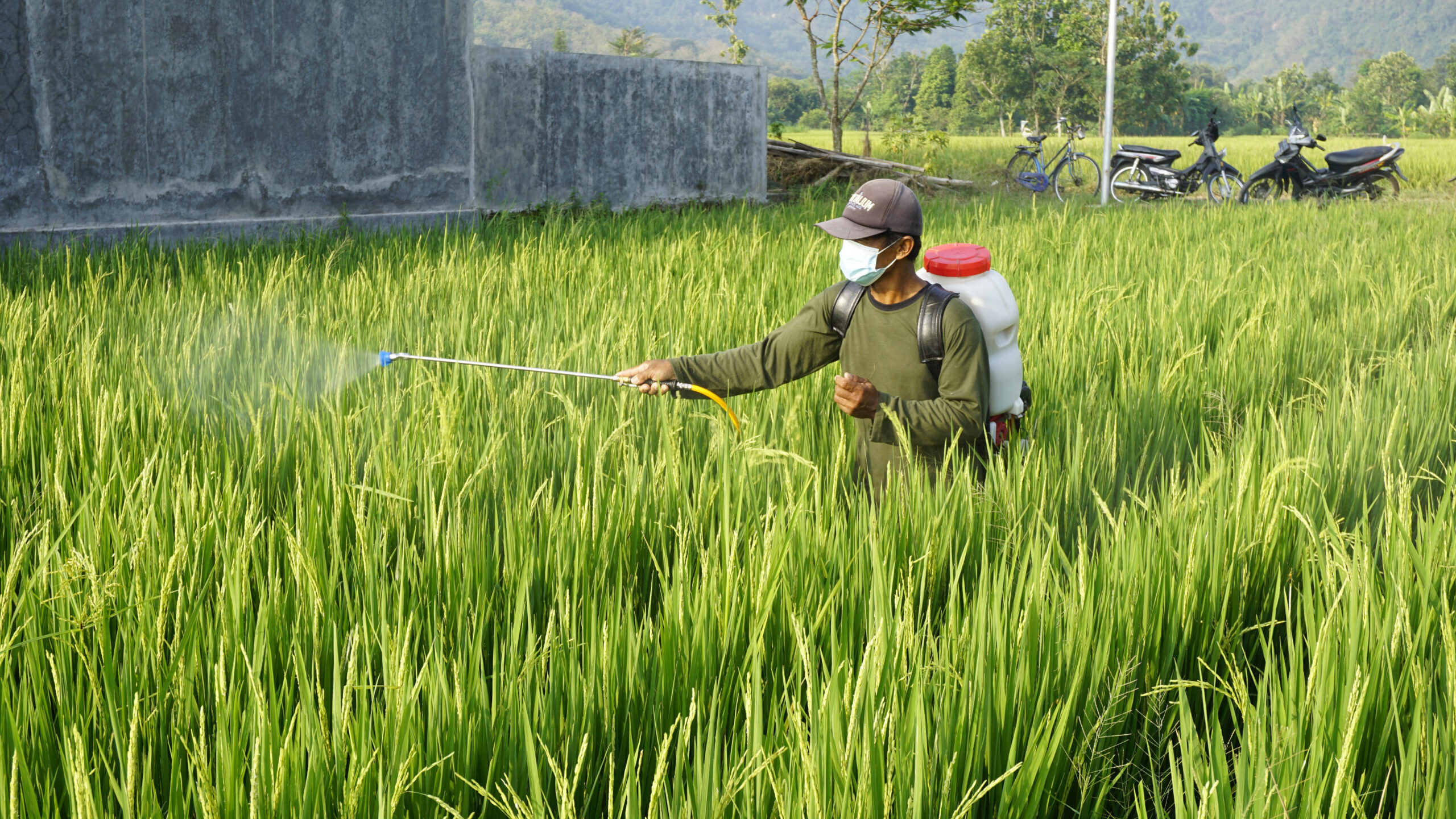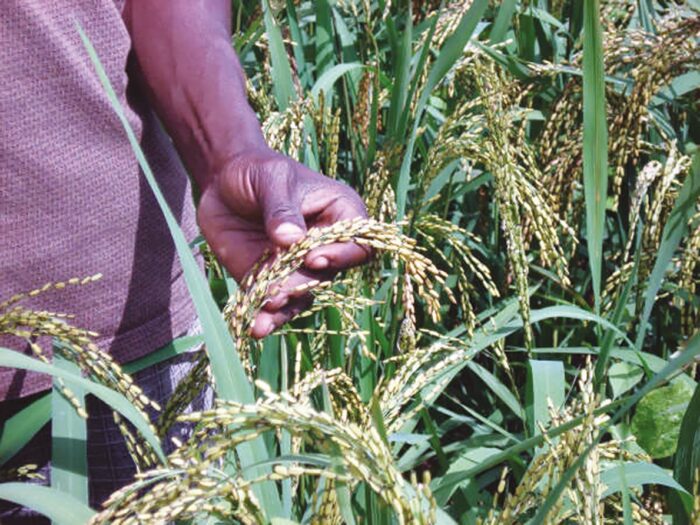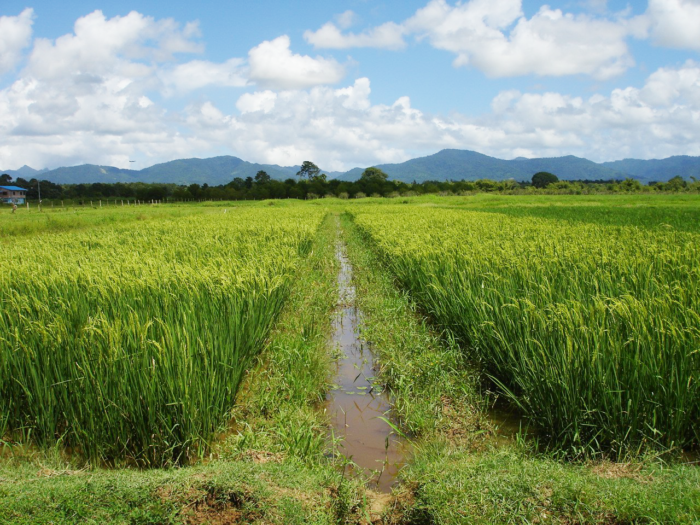
RICE IS ESSENTIAL in sustaining food security within more than half of the world’s population, and is the primary crop and main staple. While rice is traditionally associated with Asia the small-grain, tropical cereal remains the predominant dietary energy source in Sub-Saharan West Africa and the second most important source of calories for Africa as a whole.
Rice is the fastest growing food staple, with demand increasing at over 6% per annum, fuelled by population growth, urbanisation, and changes in consumer preferences. Rice is grown in 40 out of 54 African countries with the crop’s cultivation being the principle activity and income source for over 35 million small farmers. That said, local production only satisfies around 60% of current demand for rice in Sub-Saharan Africa, with 15 million tonnes having to be imported every year at a cost of US$6bn, thereby swallowing up a significant amount of Africa’s foreign exchange reserves.
Africa accounts for only 15% of the world population, but 32% of rice imports worldwide. However, rice is the least internationally traded of all the main cereal crops which makes self-sufficiency all the more important. This was seen in the ‘Rice Crisis’ of 2008 when big importers of rice were ‘stung’ with huge import bills due to rice reaching prices of US$1000 per tonne, and in the worst case scenario not being able to access the food staple for their populations.

High-yielding hybrid varieties are now cultivated in countries along the coastal region of West Africa as pictured here in Edo State, Nigeria. Image Credit: Nick Ashton Jones
That said, Africa has the human, physical and economic resources to produce enough quality rice in a sustainable manner to feed itself and export to other regions in the long run. This can only be achieved by innovation to get the rice agronomy right. Rice crop nutrition and fertilisation is the centrepiece in this scenario with foliar feeding driving the innovation needed.
Rice requires the full gambit of essential plant nutrients in measured amounts with application timing in relation to stage of rice plant development as the key to success. Only foliar feeding using soluble nutrient products can realistically deliver so many nutrient requirements in exact amounts and with the precision timings required.
Foliar feeding along the rice crop cycle
Foliar feeding is all about timing in relation to stage of crop development, so I asked Dr Ben Odunlami to start at the beginning and take me through the sequence of OMEX product applications as the rice crop grows, develops and matures.
Seed dressings to start with
“Rice seeding stage is when we apply zinc as our OMEX Primer Zinc Bio delivered as a seed dressing at 3 ml product/kg rice seed,” said Odunlami. Application at this earliest stage in the crop cycle will ensure sufficient zinc is delivered for a high quality rice grain harvest. Rice grain should contain 40-60 mg Zn per kg for enhanced human nutrition. OMEX Primer Zinc Bio is a high concentration suspension seed treatment containing 700 g/l (70% w/v) Zn with a natural biostimulant sourced from a specific marine alga (seaweed).
Giving a spurt to seedling growth
Natural biostimulant sourced from seaweed also features in OMEX Bio 20 used to boost the growth of rice seedlings in the nursery beds. “OMEX recommends OMEX Bio 20 for nursery rice seedlings as a foliar spray at 1.0 l/ha,” said Odunlami. “The beauty of our OMEX Bio 20 is the broad-spectrum complement of essential plant nutrients. This includes all three macronutrients (nitrogen, phosphorous and potassium) each one at 20% w/v, magnesium, a full complement of chelated micronutrients and all boosted by a natural biostimulant sourced from seaweed,” Odunlami told African Farming. He further explained how OMEX Bio 20 is custom-designed to furnish rice seedlings with a complement of nutrients and a biostimulant boost to promote and energise greater root biomass for maximum uptake and utilisation of water and nutrients.
Second boost and shot of zinc
When transplanted rice seedlings are at the tillering stage, it is time for a second boost from OMEX Bio 20 (1.0 – 2.0 l/ha foliar spray) and a second shot of zinc, this time from OMEX Kingfol Zn, which is also applied as a foliar spray. “OMEX Kingfol Zn is a stand-alone zinc-nutrient product in a flowable formulation containing 700 g/l (70% w/v) zinc. Small particles of zinc oxide are formulated with enhancers to maximise foliar uptake,” said Odunlami.
Sulphur and copper
Sulphur and copper are not widely talked nutrients but essential nevertheless and none more so than in rice cultivation. Sulphur is a crucially-important component of plant proteins, both structural and enzyme proteins, and now more important than ever as ‘greening of the environment’ removes the high levels of pollutant sulphur which cereal crops used to use as a source of sulphur. Another compounding factor is how deficiency symptoms in cereals including rice are difficult to distinguish from symptoms caused by nitrogen deficiency.
That apart, OMEX has the answer for rice with a product called OMEX Sulphomex. Ben Odunlami told African Farming how this novel liquid product containing 87.50% w/v sulphur is quickly absorbed by the rice leaves, thus avoiding the unpleasant dust particles and caking characteristics of many elemental sulphur products sold in powder form.
As a micronutrient, copper is only required in trace amounts but deficiencies can have severe consequences for rice. Metabolic functions of copper include being a co-factor for the activation of enzymes and for phenolic compounds which assist in the suppression of the many microbial pathogens which attack rice. Copper requirements in rice are satisfied by the application of OMEX Zynergy, containing 2.66% w/v copper and which also provides additional boosts of zinc (4.72% w/v) and sulphur (9.10% w/v).
 Panicle initiation and spike emergence stages
Panicle initiation and spike emergence stages
Vegetative growth continues but is now over-shadowed by the all-important reproductive stage including initiation of the rice panicle and emergence of the spike. This requires a whole new set of nutrient priorities while keeping vegetative growth in tandem with this new reproductive development. Calcium and boron are key nutrients in reproductive development. Calcium minimises the occurrence of split rice grains, while boron controls the synthesis of cell wall material and also plays a role in the transport of soluble sugars across cell walls.
Breadth and balance in nutrient provision at this critically demanding time is satisfied by a cluster of OMEX products:
- OMEX Calmax B (calcium 22.5% w/v; boron 1.53% w/v plus chelated micronutrients, nitrogen and magnesium applied as a foliar spray at 2.0 l/ha)
- OMEX K41, a water soluble emulsion with a super-high (41% w/v) potassium content
- OMEX Bio 20 and OMEX Kingfol Zn as foliar sprays
- OMEX Sequential 2 with a full complement of nutrients including potassium at 40% w/v. This product is recommended for rice farmers in countries where OMEX K41 may not be available.
Potassium improves root growth and vigour, assists in the prevention of lodging and enhances rice plant resistance to pests and diseases. Moreover, it also controls water relations in the plant and is therefore called the ‘gatekeeper’ nutrient.
Potassium is usually the most limiting nutrient after nitrogen in the high yielding rice systems which increasingly typify African rice cultivation. Breakthroughs came with the use of high yielding varieties developed by hybridising Oryzae sativa and Oryzae glaberrima. A classic example is ‘NERICA’ rice, appropriately translating into ‘New Rice for Africa’.
Potassium is required throughout the life cycle of the rice plant. However, given its importance in grain filling, prevention of lodging and rice plant resistance, the most important intervention is at the panicle initiation and spike emergence stages.
Shortfalls of potassium cause a wide range of deficiency symptoms including leaf discolouration, unhealthy black roots, more unfilled grains, reduced grain weight and greater lodging. Foliar feeding is ideal for potassium because the cations are highly mobile, both into and within the rice leaves.
There are clearly great demands for potassium in rice cultivation, so I asked Ben which OMEX products would satisfy rice requirements for this nutrient. “Our key product is OMEX K41 with super-high potassium at 41% w/v and applied at 3.0 l/ha as a foliar spray. The soluble emulsion product also contains nitrogen, magnesium and sulphur. For countries where OMEX K41 may not be available, we offer rice farmers OMEX Sequential 2 containing 40% w/v potassium,” said Odunlami.
Complete package
Attending to and satisfying the needs of a crop like rice with nursery, transplanting and paddy water requirement considerations is no easy task, but made much easier to control and with assured success using the soluble nutrient product package from OMEX to foliar feed rice crops.
Article by Dr Terry Mabbett.
